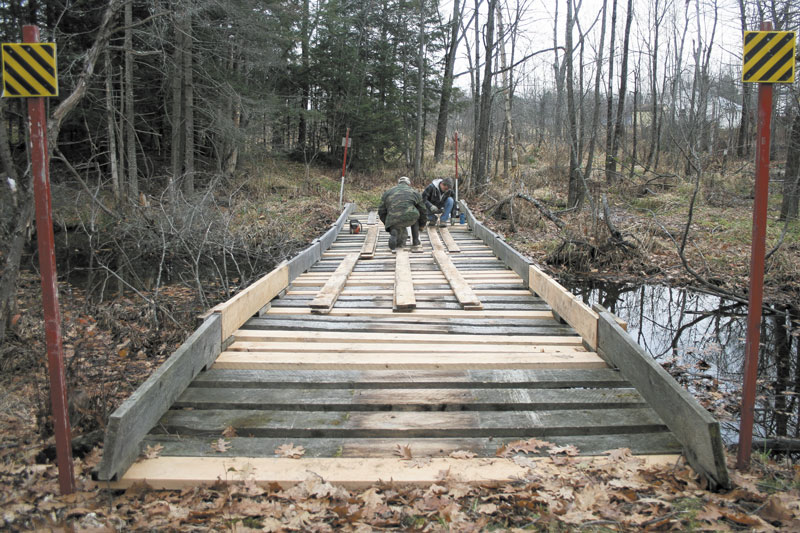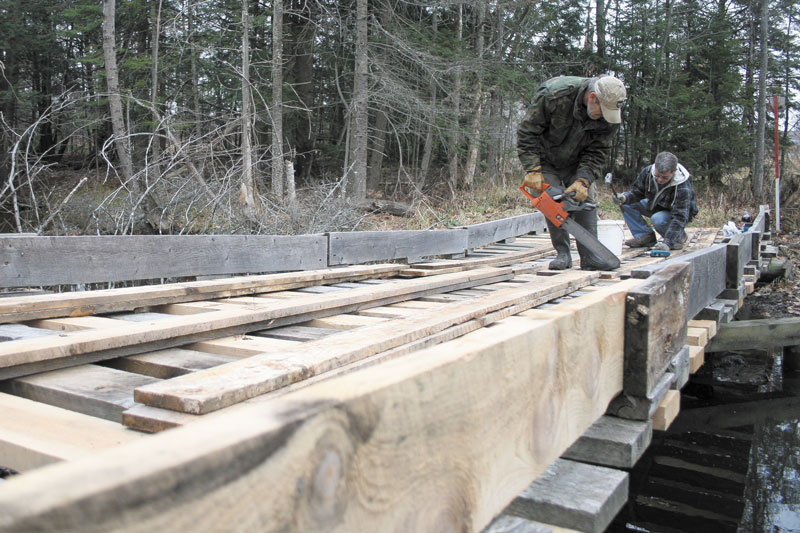BY BEN MCCANNA
Staff Writer
Eric Roberts, president of Central Maine Snowmobile Club, knelt on a wooden bridge Sunday and swung a hammer.
Roberts and the club’s trail master, Robert Bickford, were busy replacing the bridge’s aging lumber with fresh, sturdy boards.
“The wood was questionable, so here we are,” Roberts, 47, said. “And, there are always plenty of these (bridges) to do every year.”
Central Maine Snowmobile Club is an organization that maintains eight miles of snowmobile trails in Waterville. Although the club has about 20 members, Roberts and Bickford, 49, are the only two members who stroll their network of trails every fall to clear fallen trees, trim brush, repair bridges and more.
“Most of our members are older gentlemen — the founding fathers of the club from years and years ago,” Roberts said. “They range anywhere from 78 to 84 years of age.
“Basically there are just two of us that actually go out and do most of the work.”
A shortage of volunteers is not unique to the Waterville club, Roberts said. Throughout Maine, snowmobile clubs are struggling to find young blood and strong backs to keep trails open.
Maine boasts 287 individual snowmobile clubs, which belong to the Maine Snowmobile Association.
The association’s reach is extensive.
“Snowmobile club volunteers have been developing and maintaining this system of winter trails since the 1960s, a system that has now grown to over 14,000 miles of groomed and marked trails, interconnecting communities from the suburbs of southern Maine, downeast to the coastal plain, through the western and northwestern highlands and on to the farmlands and deep woods of northern Maine,” according to its website.
The association has about 13,500 families and 2,200 businesses on its membership rolls.
Lack of volunteers
Despite robust membership numbers statewide, only five to 10 percent of members volunteer for trailwork, according to Bob Meyers, executive director of the Maine Snowmobile Association.
Meyers said the lack of volunteers might be due to economic shifts.
“It’s tied into the way people live their lives now, unfortunately,” he said. “People are working longer hours. Just about every household has two working members. People’s lives have become very busy and very complicated.
“It leads to people making choices on how they spend their leisure time. And, that time has diminished quite a bit over the years.”
John Fortin, president of the Kennebec Valley Trail Riders club in Vassalboro, said the continuity of Maine’s trails is threatened by low numbers of volunteers.
“If it keeps up like this, if we don’t get people into the clubs and helping and being active, then these trails are going to go away,” he said. “You won’t have the option of coming home at night and riding nice, local trails. You’d have to wait for the weekend to travel and spend time up north.”
Fortin, 22, is one of the youngest members of a 25-member club, and only about five members participate in annual trail maintenance.
“The majority of the guys who do work are 50 and older,” he said.
Fortin said he has appealed to younger riders to join the club and perform maintenance.
“But they don’t have any interest,” he said.
Meyers agreed that the trail network could shrink without volunteers. And, a reduced network could affect the state’s bottom line.
“From a statewide perspective, the estimated economic impact (of snowmobiling) is $300 million-plus a year.” he said. “It supports a lot of businesses.
“And the whole infrastructure that supports this is built on volunteer labor. Depending on your perspective, that’s either really cool or really scary.”
It’s hard work
Trail maintenance is hard work. And it doesn’t stop when the snow flies.
Roberts and Bickford have been working together on trail maintenance since 1989, and they estimate it takes 160 man-hours to prepare for the season. The work generally begins in late October or early November.
Then, once riding gets under way in late December, the men log an additional 100 man-hours to keep the trails groomed.
Roberts said the logistics of fall maintenance are complicated.
Most trails are closed to ATV traffic so, when there’s no snow on the ground, there’s no way to assess the trails’ needs without traversing the entire system on foot. Often, the men must carry their tools and materials to job sites.
“In the eight miles, we probably have 12 snowmobile bridges,” Roberts said. “There are always a few that need to be repaired, and it’s hard to get the materials in to the bridges this time of year. It’s always a struggle, that’s for sure. It takes a lot of time.”
Some winters, Roberts and Bickford will use snowmobiles to drag lumber into the woods, so it can be stashed in advance of the fall maintenance season.
Despite the hardships, Fortin said the work is rewarding.
“It’s a great group of guys to work with,” he said. “You get friendship. You get to know people around town by talking to landowners.
“And, you definitely get that sense of accomplishment and pride in your work.”
Bickford said riders should feel obligated.
“If you enjoy the sport, you should belong to a club so you have stuff like this to ride on,” he said.
Ben McCanna — 861-9239
bmccanna@centralmaine.com
Send questions/comments to the editors.




Comments are no longer available on this story